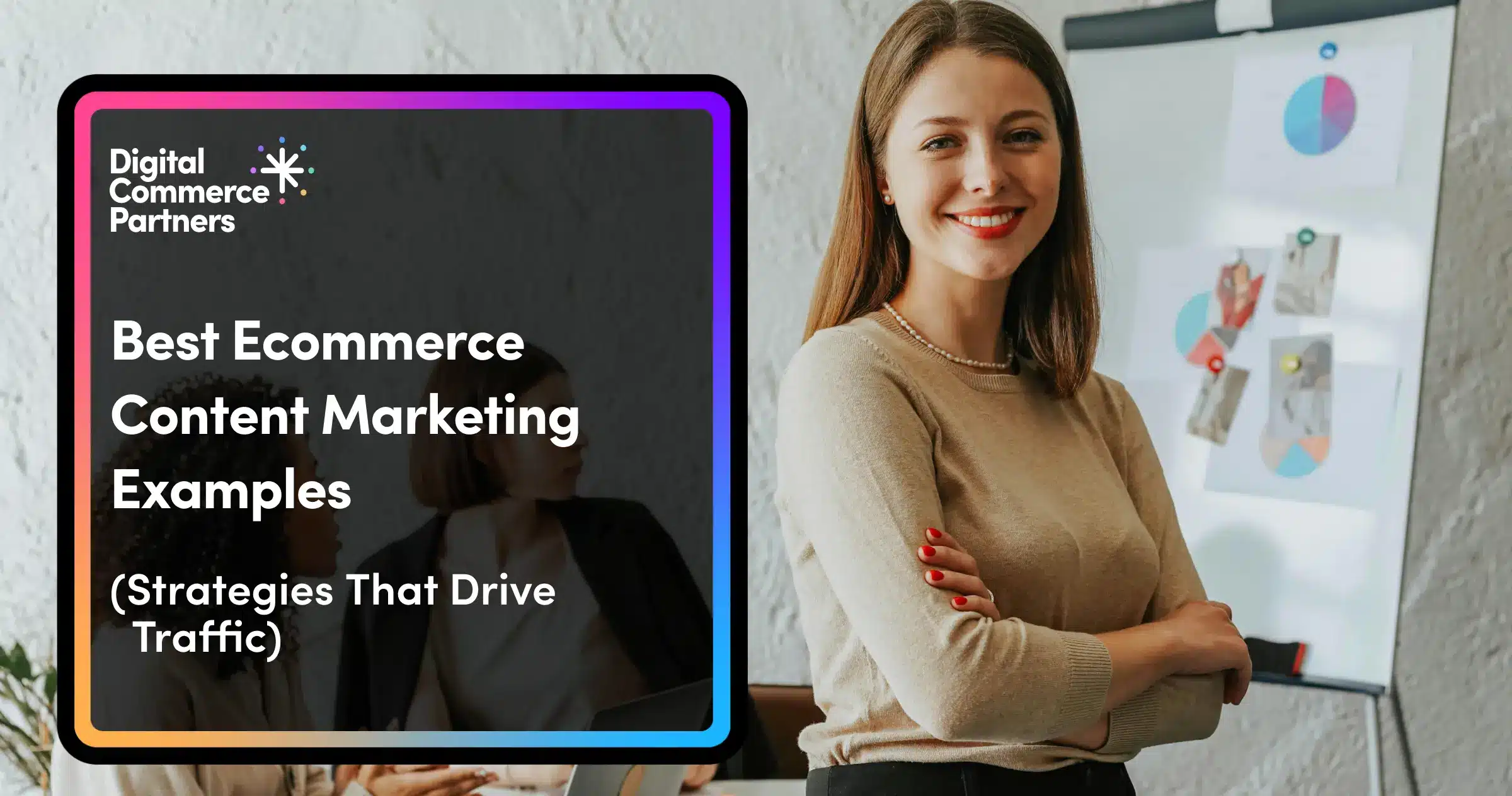When it comes to ecommerce content marketing, it might surprise you to know that the most profitable content on your site probably already exists. While many brands chase viral blog posts and trending topics, the real opportunity is likely hiding in plain sight.
Take one of our clients in the smart home space. Instead of creating more content, we optimized their existing category pages. Within three months, their traffic tripled.
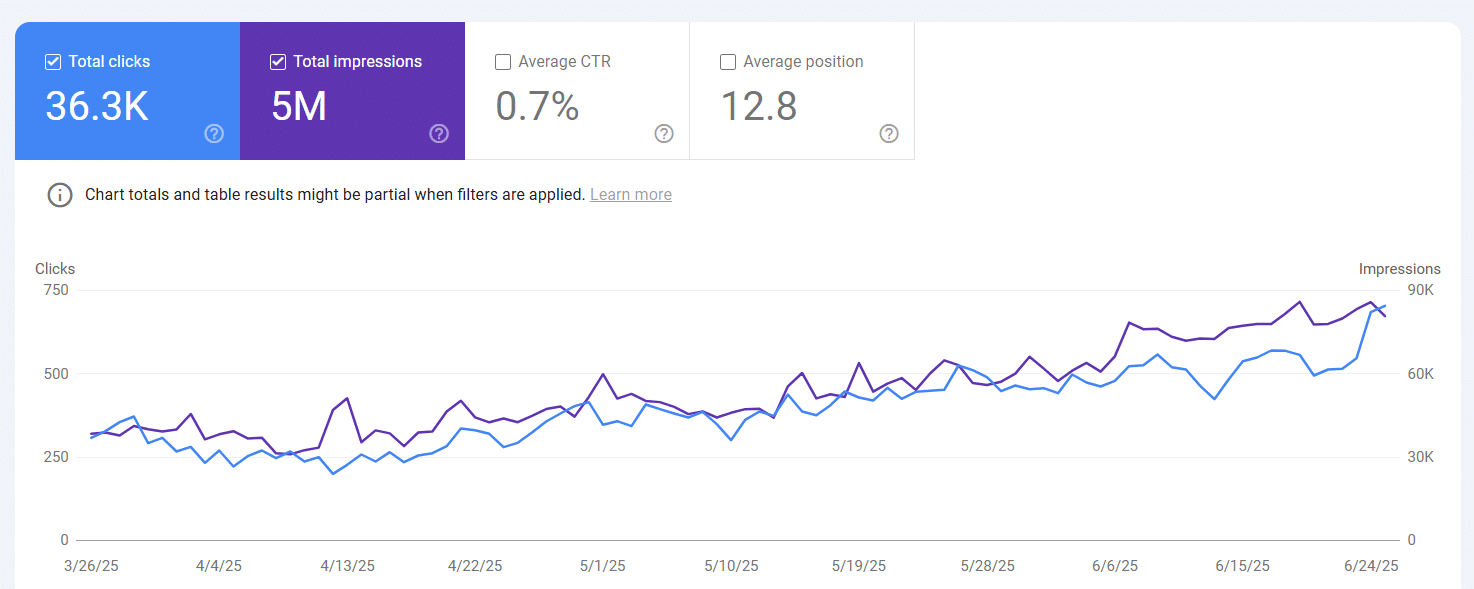
That’s the power of making your content work harder.
The following ecommerce content marketing examples break down how brands are doing just that. They utilize focused, strategic content to enhance SEO, drive conversions, and foster long-term customer trust.
Even with a lean team or limited publishing bandwidth, you can apply the same principles to your store.
You’re here for results. So are we.
An SEO audit by DCP helps you uncover the technical issues, content gaps, and competitor advantages that stand between your business and maximizing ROI from search.
Included in this article:
Product Page Content Examples
Let’s kick things off with one of the most impactful types of ecommerce content marketing examples: product pages.
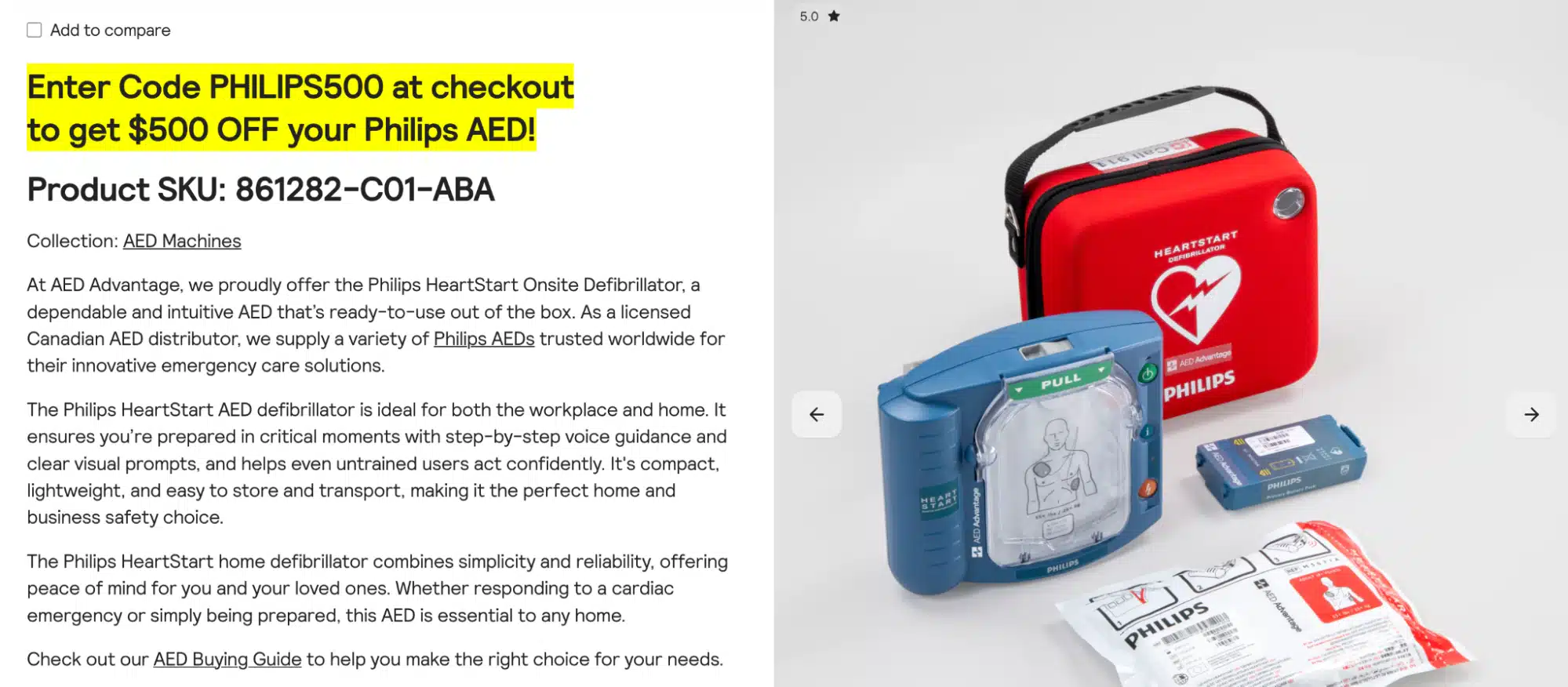
A well-optimized product detail page (PDP) is a high-intent SEO asset. It’s a trust builder and an opportunity to answer the exact questions your customers have before they’re ready to make a purchase.
Get it right, and your PDPs will start ranking for long-tail queries, reducing bounce rates, and converting faster.
Here’s how leading brands are turning product pages into serious growth engines:
1. Use Product Descriptions That Anticipate Buyer Questions
A high-performing product page isn’t just a place to push transactions. Great ecommerce product content should do three things well:
- Answer buyer questions clearly
- Guide users to related products
- Build trust with reviews
When done right, a PDP supports search, reduces bounce, and nudges shoppers toward conversion, all from a single page.
Proper Cloth sets the bar here. Take the following page, for example. Here, you won’t just find measurements and fabric specs. You’ll see exactly when to wear the shirt, how to style it, and why it’s worth the price. The copy explains, reassures, and sells without sounding like a spec sheet.
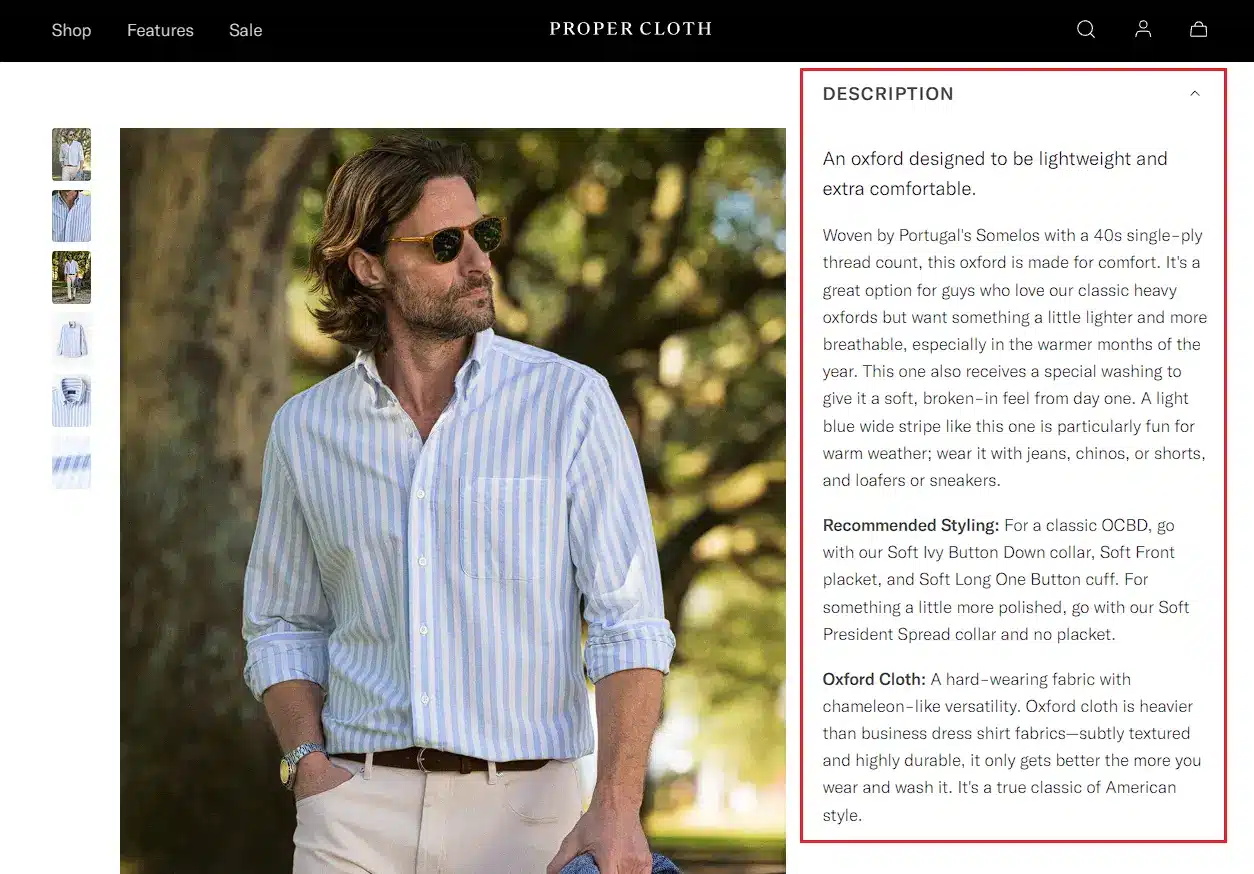
This page meets shoppers where they are. Someone searching for a “lightweight Oxford shirt for weddings” doesn’t want to be talked at.
They want clarity, confidence, and a reason to trust you. That kind of targeted, benefit-first copy helps the page rank for long-tail queries with purchase intent.
You don’t need a massive content team to do this.
Start by adding two lines of real-life context: who the product’s for, when it shines, and what makes it different. Pull FAQs from your inbox. Use plain language. Write like you’re helping someone make an informed decision (because that’s exactly what you’re doing).
We’ve applied this exact strategy across dozens of client projects, and it consistently delivers.
For one client—a DTC clothing brand—we revamped their PDP copy to include clear, benefit-driven product descriptions. The result was a substantial increase in organic traffic and stronger engagement across key product pages.
2. Related Products That Help Customers Decide
Strategic product pages don’t leave shoppers hanging. Alongside clear descriptions and trust-building reviews, they guide the next click. One of the easiest ways to do that is with related products that make sense, both for the customer and your business goals.
Seven Sons Farms nails this with their curated meat bundles. Instead of just listing individual items, their product pages recommend relevant add-ons, such as ground beef, pork bacon, or breakfast sausage that complement what the shopper is already considering.
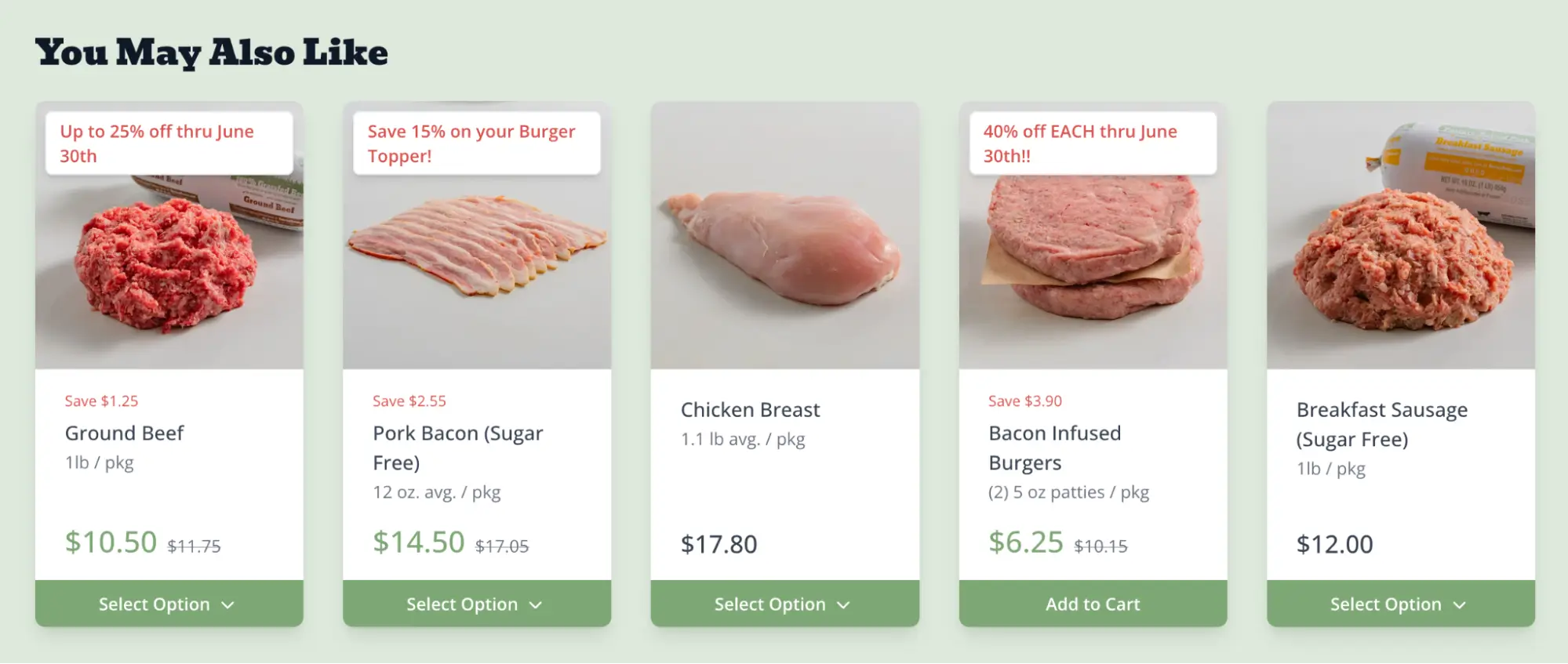
This simplifies decision-making, especially for newer customers who aren’t sure what to buy. And because these links are internal and contextual, they improve crawlability and help search engines understand the relationships between your products.
Start with a handful of your top-performing SKUs—short for stock keeping units, which are simply the unique identifiers for each product you sell.
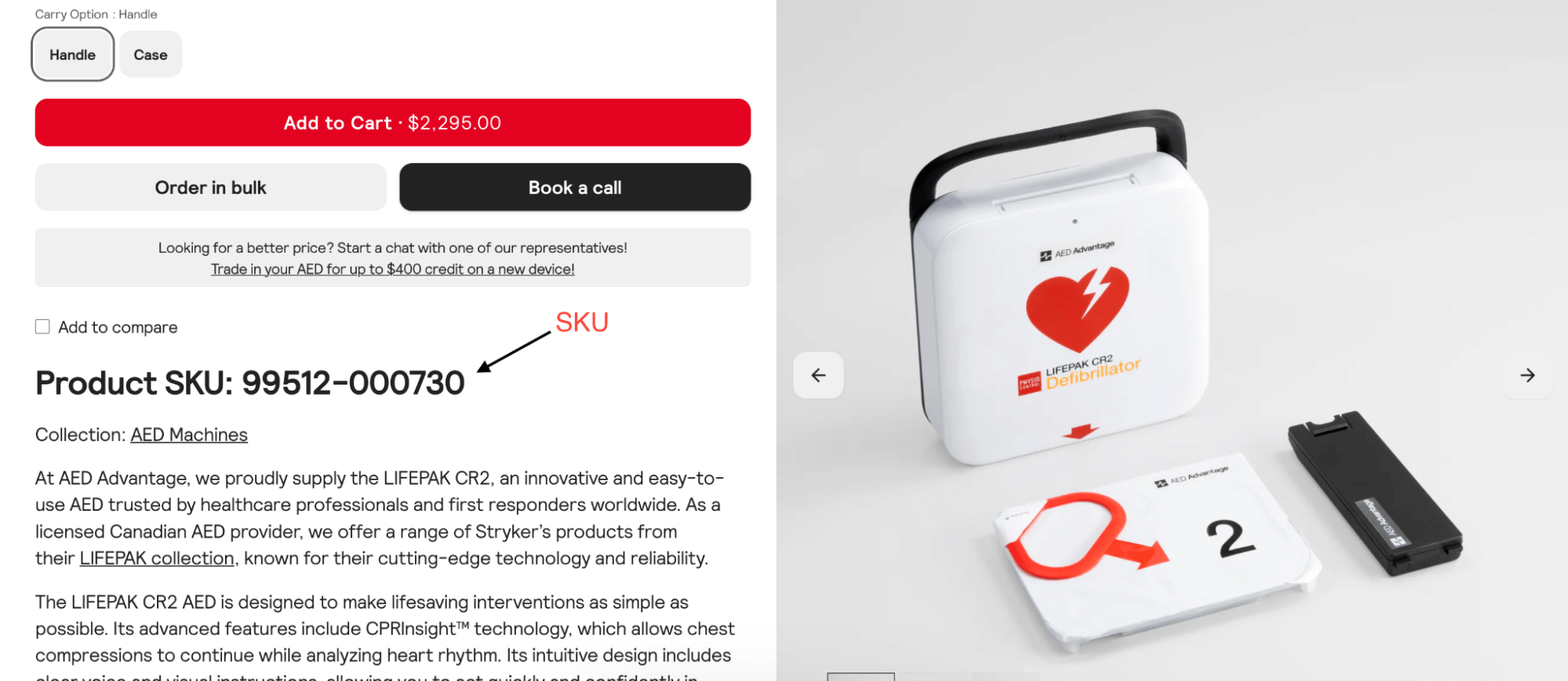
Then look for natural pairings based on customer behavior, purchase patterns, or use cases. For example, if customers often buy a cast-iron skillet, recommend and link to accessories like seasoning oil, a lid, or a cleaning brush.
Guide the shopper. Reduce the friction. Structure your internal links in a way that directs both people and search engines in the right direction.
That includes AI-powered search, too. Tools like ChatGPT and Google’s Search Generative Experience (SGE) summarize content and extract context from your site. This means internal linking isn’t just about SEO hygiene anymore. It’s how AI systems understand the relationships between your products and recommend them more accurately in AI-driven answers.
For example, let’s say Seven Sons’ ribeye steak page consistently links to other proteins, such as chicken breast and pork shoulder, with clear anchor text and helpful descriptions. AI summarizers might start bundling those items in responses to meal-planning or “best meat bundle” queries.
That’s why internal linking is one of our core strategies. We use it to mimic real-life decision-making. The thought process is: “If a shopper is here, what else might they need?” From there, we link with intent.
3. Reviews That Do More Than Star Ratings
Great product pages don’t rely solely on brand copy. Reviews carry the weight of trust, especially in D2C ecommerce, where shoppers can’t touch or try before they buy.
When done right, reviews support ecommerce SEO and help undecided buyers make informed decisions.
Printfresh puts this into practice beautifully.
Scroll past the product gallery, and you’ll find real customer reviews. These include not just star ratings but personal anecdotes and lifestyle details.
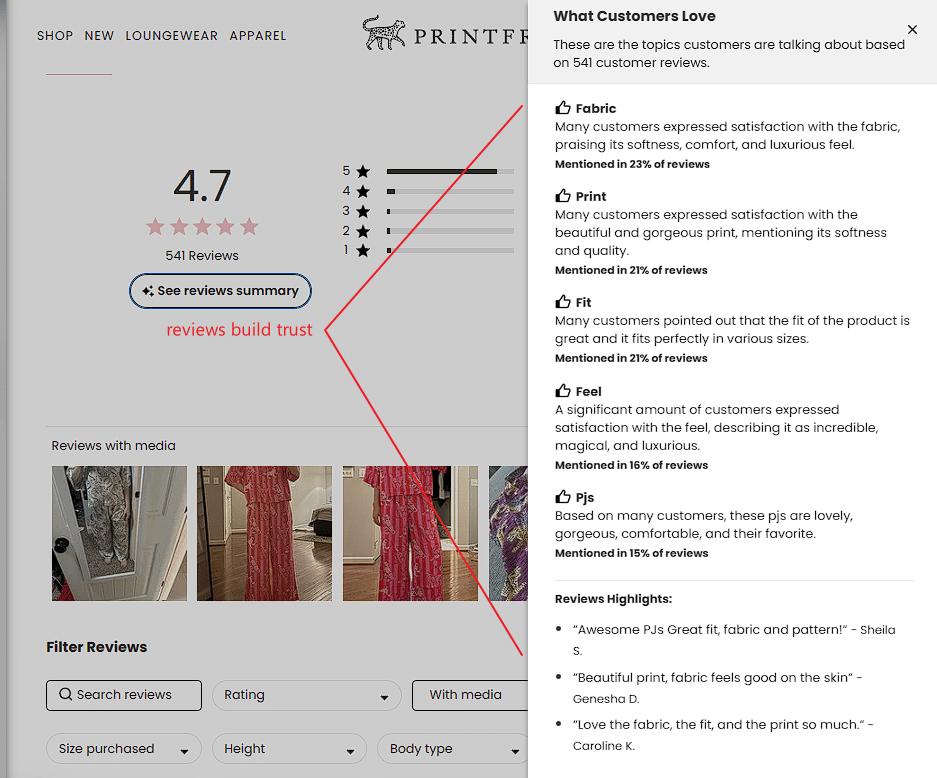
Shoppers mention gifting the set to friends, packing it on vacation, or loving the silky feel in warm weather. Some even include photos that showcase the fit, fabric, and vivid patterns in real-world settings.
This kind of content builds trust quickly. It also loads the page with keyword-rich phrases, such as “eco satin pajamas for hot sleepers” or “lightweight pajama set for summer.” That’s SEO gold, and it’s coming straight from your customers.
You don’t need hundreds of reviews to see the impact. Start by asking buyers to share how they used the product or what they loved most about it. Make it easy to upload a photo. Add filters like “Size” or “Best For” so future customers can sort by relevance.
Collection Page Content Examples
The next set of ecommerce content marketing examples comes from brands optimizing their collection pages.
Collection pages should function like curated guides. They help shoppers understand what’s worth considering, why it matters, and how to make informed choices.
These pages are built to rank for mid-funnel (the stage where someone is actively researching and comparing products) keyword searches like “best organic cotton sheets” or “eco-friendly pajamas.”
And because well-structured collection pages keep users engaged longer, they send strong signals to search engines (and AI models) that your content is helpful and worth ranking.
Below, we’ll look at a few brands turning their collection pages into decision-making tools rather than simply product feeds.
1. Content Blocks That Preempt Objections
Most shoppers arrive on a collection page with questions. The mistake is assuming they’ll go dig for answers. They won’t. That’s why the best collection pages answer key concerns directly, before hesitation turns into a bounce.
Brilliant Earth does this exceptionally well. Their engagement ring collection pages include sections that tackle buyer doubts head-on.
Questions like “How much should an engagement ring cost?” or “How many carats should an engagement ring be?” are addressed right on the page, not buried in a support center or policy page.
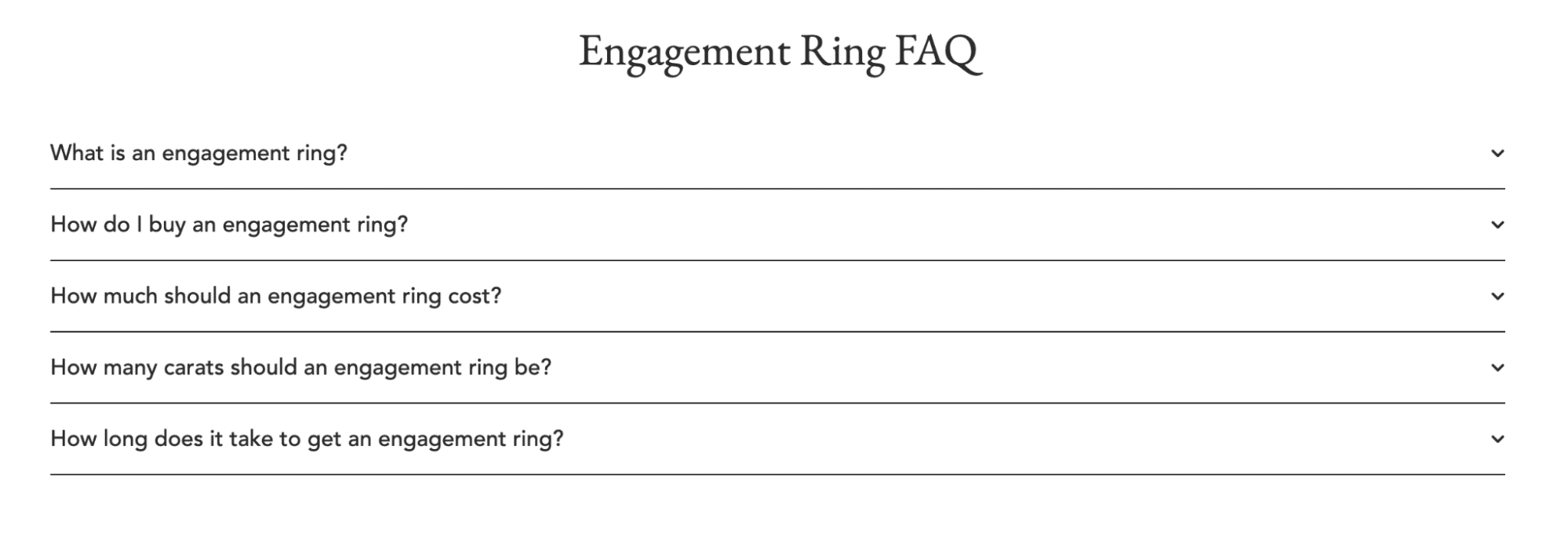
This content is brief, clear, and strategically placed just below the product listings.
It works because it reduces friction in the exact moment when shoppers are comparing options. It also adds keyword-rich, intent-driven content that enhances the page’s relevance for search terms such as “conflict-free engagement rings” or “lab-grown diamond rings with warranty.”
You don’t need to overthink it. Start by identifying two or three questions that you, your support team, or even your social media manager hears repeatedly. These are the concerns real shoppers bring up in live chat, DMs, comments, reviews, or post-purchase emails.
Include a few commonly asked questions and answers as a content block near the bottom of your most visited collection pages. Use the FAQ schema (structured data that marks up Q&A content) to make it crawlable by search engines. You can find out exactly how to do this in our article on ecommerce schema for product pages.
We’ve used this exact strategy to help ecommerce clients reduce bounce rates on high-traffic collection pages. It works because you’re answering the exact questions that make or break a decision before the shopper ever thinks to ask. That’s what turns a passive browser into a confident buyer.
2. How-to Content Embedded in Collection Pages
Not every shopper knows exactly what they’re looking for. That’s why some of the most effective collection pages blend product discovery with lightweight education, right where decisions happen.
REI does this with intention. On their tent collections, you’ll find more than a list of tents and sleeping pads. They include helpful context, such as “How to Choose a Tent” guides, packing lists, and quick explanations on topics like 3-season vs. 4-season builds. It feels like a conversation with an expert, not a hard sell.
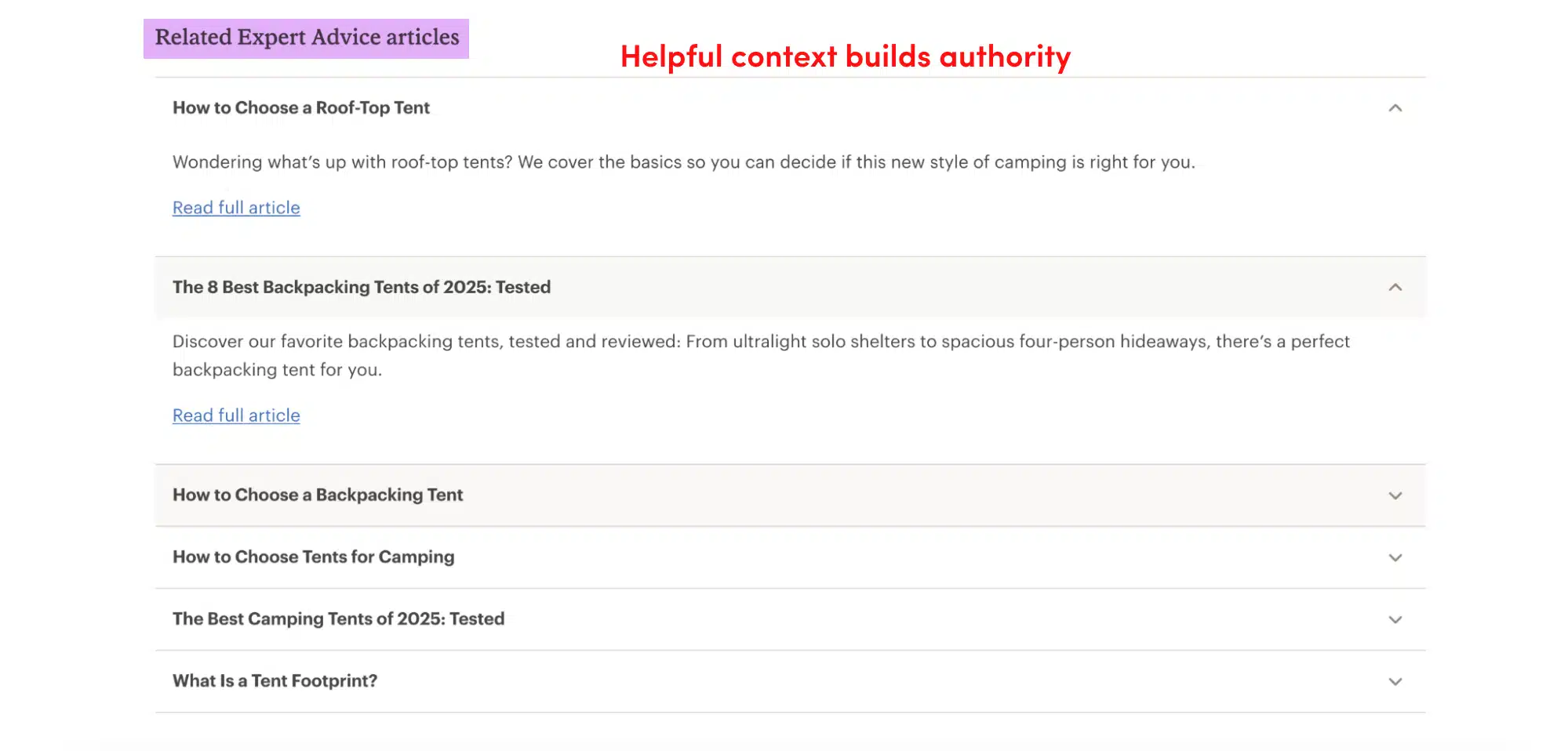
This kind of embedded content builds trust fast. It keeps users engaged longer, supports mid-funnel keywords, and nudges hesitant buyers toward confident decisions, all without requiring them to leave the page.
If you’ve already published help center articles or blog posts, you don’t need to reinvent the wheel.
Pull the most relevant section and add it directly to your collection page. Keep it brief. Use anchor links to make long pages easier to navigate. Even a short paragraph of well-placed advice can turn casual browsers into ready buyers.
Ecommerce Blog Examples That Work (And What You Can Learn From Them)
Ecommerce blogs often get overlooked, but they can be powerful tools for building traffic and authority. A well-structured blog should do three things. First, attract qualified traffic. Then, rank for high-intent keywords. Finally, it should earn trust before someone ever lands on a product page.
Let’s look at a few examples.
1. Informational Posts That Rank and Convert
The best blog content answers questions your customers are already asking. Gymshark excels at this.
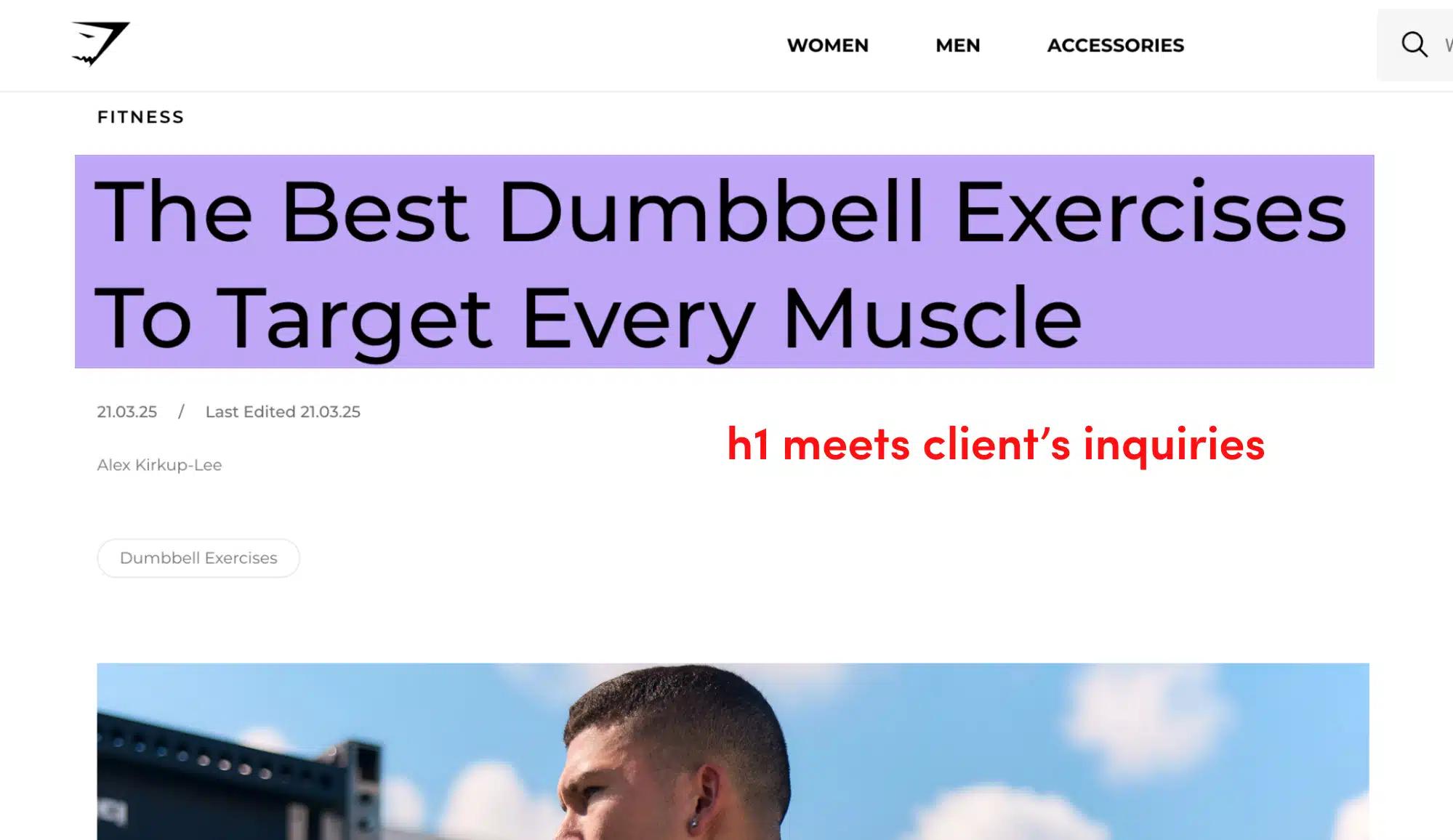
Take a look at the image above. It’s exactly the kind of post someone would search for while looking for dumbbell workouts—and it meets that need head-on.
This isn’t just educational content for the sake of publishing something. It’s built around a high-intent query (dumbbell workouts). It also offers clear and actionable guidance and reinforces Gymshark’s credibility in the fitness space.
Product mentions are seamlessly integrated, never interrupting the flow of information. By the time a reader finishes the post, they’ve already engaged with the brand, learned something useful, and encountered multiple pathways to purchase, without ever being pushed.
It’s a smart blend of value and subtle selling, designed to rank in search, easy to read, and perfectly aligned with the consideration stage of the customer journey.
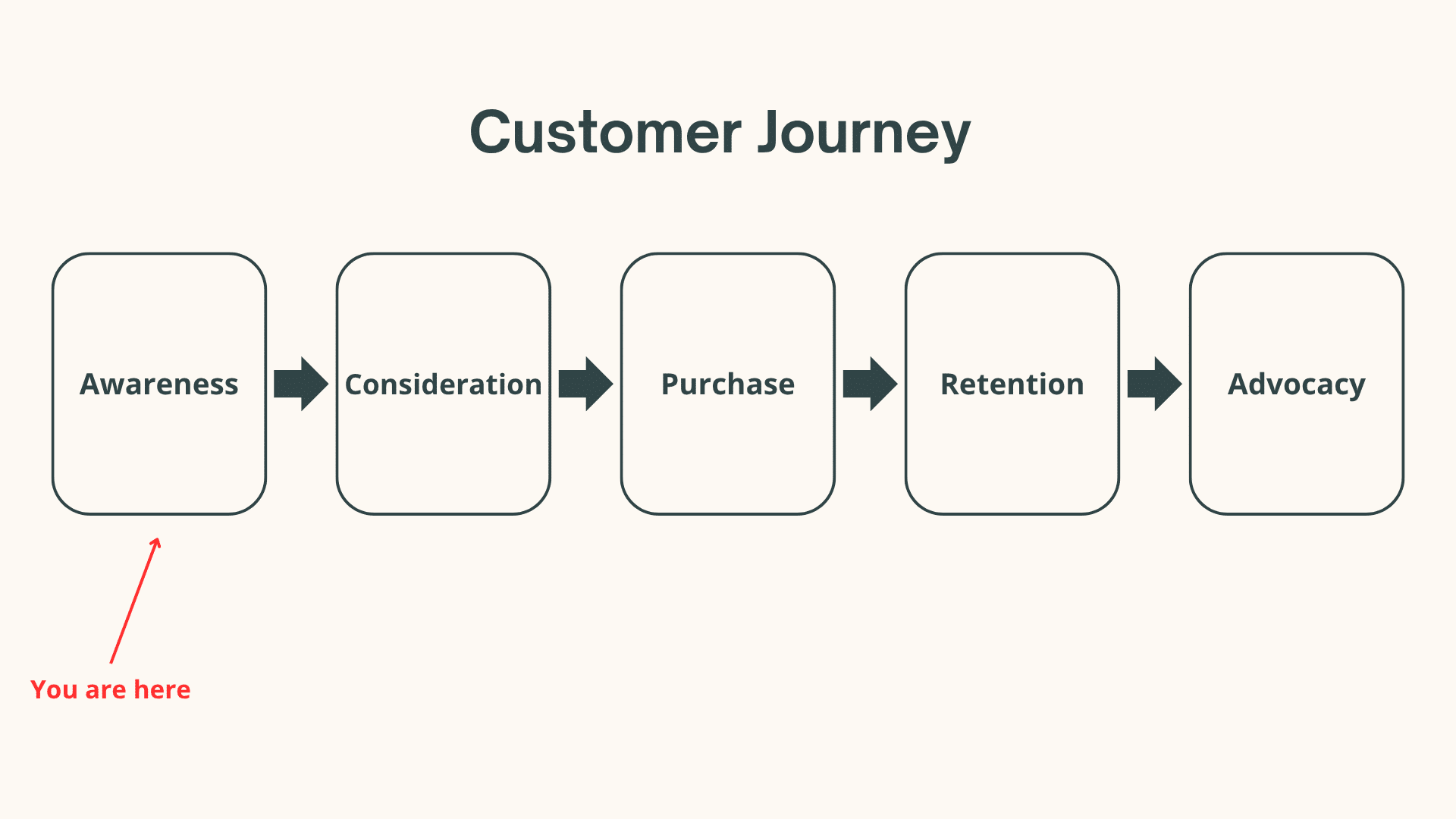
If you’re not doing this yet, a good place to start is with your most common pre-purchase questions—the things people are Googling when they’re on the fence.
This is exactly where AI-powered search tools like ChatGPT come into play. Shoppers are asking full questions, expecting direct answers, and seeking brands that can provide clarity and confidence.
When your content addresses those high-intent queries head-on, you’re meeting customers exactly where they are in their journey.
Turn each query into a standalone blog post that teaches, builds trust, and gently guides them toward the right product.
2. Newsletter-Style Editorial That Drives Retention
Not every piece of content needs to convert immediately. Some just need to keep the relationship warm. Pedaal gets this. Its blog section blends stories, gear recs, and lifestyle content into weekly dispatches that feel more like reading your favorite magazine than browsing an ecommerce blog.
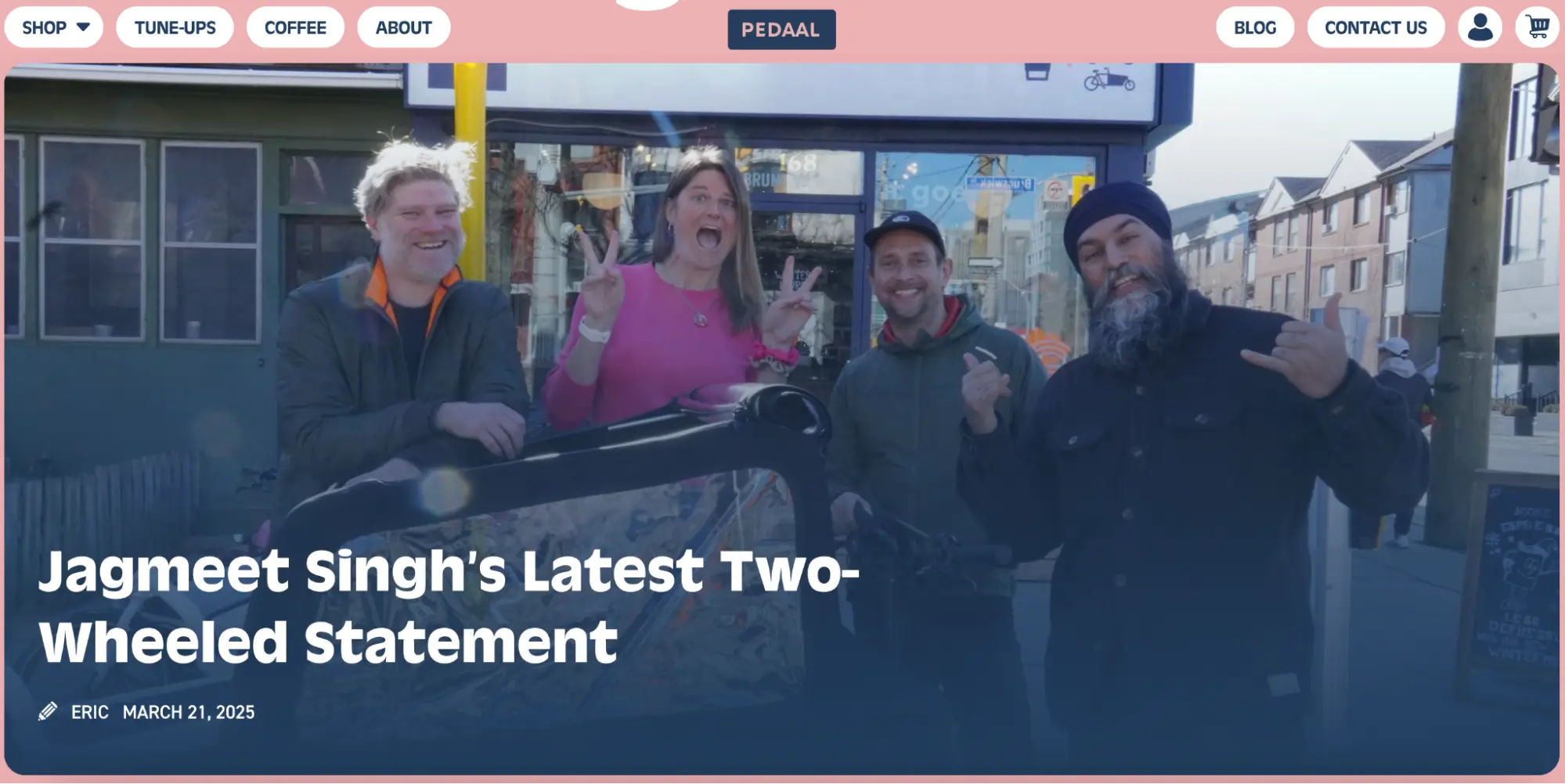
This isn’t just content for the sake of content; it’s about fostering long-term engagement. Even if someone’s not ready to buy, they’re staying connected. The style is laid-back, the curation feels personal, and the storytelling keeps past customers coming back to see what’s new.
You don’t need a full-time editor or an in-house creative team to pull this off.
Start small. Instead of overhauling your entire strategy, highlight one story, maybe a customer win or a staff favorite. Frame it with a subject line that feels personal, like a quick note rather than a formal announcement.
Publish monthly instead of weekly to build rhythm without burning out your audience. Keep the format simple: a short dispatch, a few visuals, maybe a behind-the-scenes update.
This type of content doesn’t just live on your blog. Repurpose it across your marketing channels. Drop it into your email newsletter, break it into social posts, or use it to spark conversations in your next campaign.
If your brand has a vibe worth sticking around for, this kind of editorial gives people a reason to keep showing up, even when they’re not in the buying mindset.
Landing Page Examples for Ecommerce
When built strategically, landing pages drive organic traffic and give customers the confidence to move from curiosity to purchase.
Whether it’s a limited-time promo, a seasonal buying guide, or a tool that simplifies decision-making, every ecommerce landing page should earn its place in your funnel.
Here’s how innovative brands are using landing pages to convert better.
1. Interactive Guides That Build Trust
When your product line includes dozens of similar options, the real blocker isn’t price, it’s uncertainty.
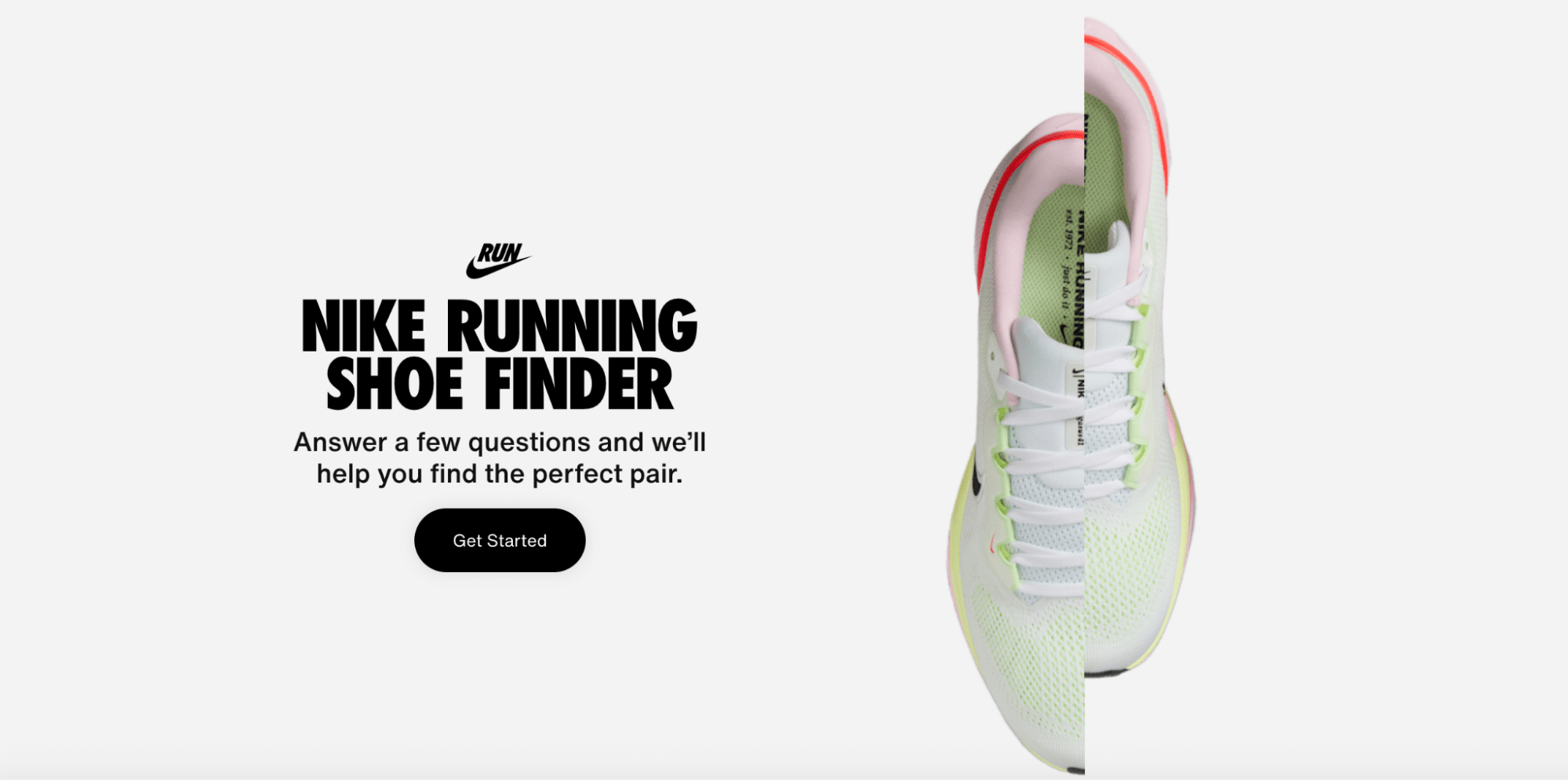
Nike tackles this with their interactive Running Shoe Finder. Visitors begin by answering a few quick questions about their typical training surface, foot type, and whether they’re shopping for road runs, trail runs, or race-day gear. The result: personalized sneaker recommendations tailored to their needs.
This isn’t just helpful, it actively builds trust. Users instantly feel seen, which reduces hesitation and increases confidence in their choice.
You don’t need to build this from scratch. Platforms like Typeform or Octane AI make it easy for small teams to launch a product finder quiz.
Keep it concise—three to five focused questions—and tie your results to curated product bundles. The goal is to make the decision easier and more personalized. Done right, this kind of interactive guide becomes one of your most effective ecommerce assets.
2. Promotional Pages That Don’t Feel Pushy
Some landing pages scream “sale.” Others tell a story and sell through alignment. Allbirds takes the second route with their Carbon Footprint campaign page, using it to break down the brand’s sustainability commitments.
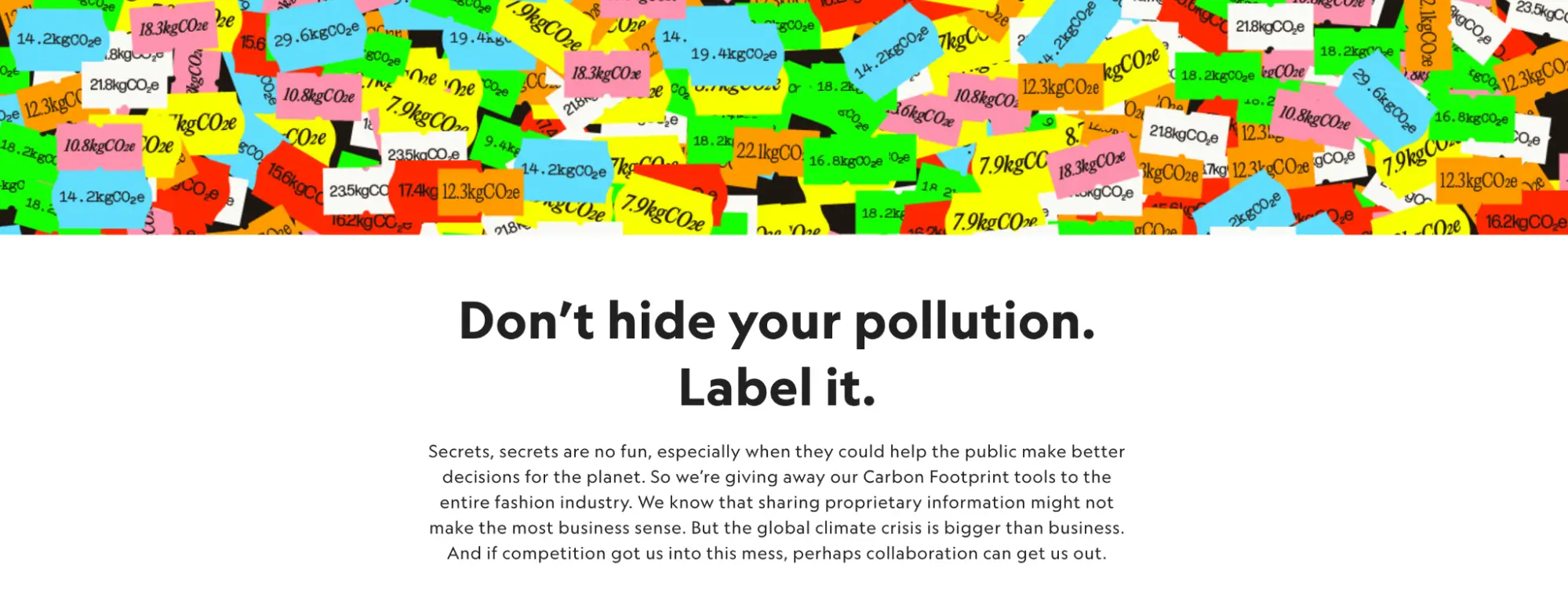
It’s all about building credibility. The copy explains how their materials reduce emissions, how their process is different, and why that should matter to the buyer. It makes the shopper feel informed, not pressured.
This kind of page doesn’t need to be evergreen to be effective. You can tie it to a seasonal moment, like Earth Day, and spotlight a product made from recycled materials or a collection focused on ethical sourcing.
Use it to expand the narrative behind your offer. Include testimonials, behind-the-scenes visuals, or data points that connect the dots.
We Know Ecommerce Content Marketing Works. Let’s Put It to Work for You.
You don’t need Nike’s design team or Huckberry’s editorial staff to see wins. What you need is alignment: content that maps to the buyer’s journey, fills funnel gaps, and drives real business outcomes.
We’ve done this for dozens of ecommerce brands across industries: refining strategy, building content systems, and executing with clarity. From product pages to long-form blog posts, we know what works and, more importantly, how to make it work for you.
Explore our Ecommerce Content Marketing Services and get in touch with us today.

